There are no other trees that I know of that offer so much beauty throughout the year as crabapples—they really are a tree for all seasons.
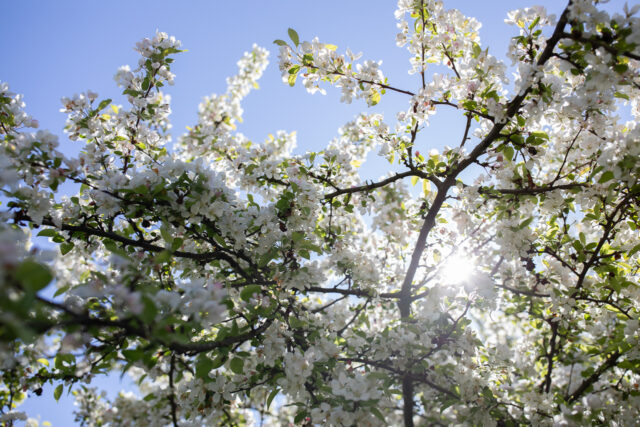 Each spring their fat buds explode into a cloud of fragrant blossoms. When the petals finally start to fade and a breeze comes along, it looks like it’s been snowing out in the garden. By June, the branches are covered in miniature fruit that is perfect for incorporating into arrangements or just admiring in place.
Each spring their fat buds explode into a cloud of fragrant blossoms. When the petals finally start to fade and a breeze comes along, it looks like it’s been snowing out in the garden. By June, the branches are covered in miniature fruit that is perfect for incorporating into arrangements or just admiring in place.
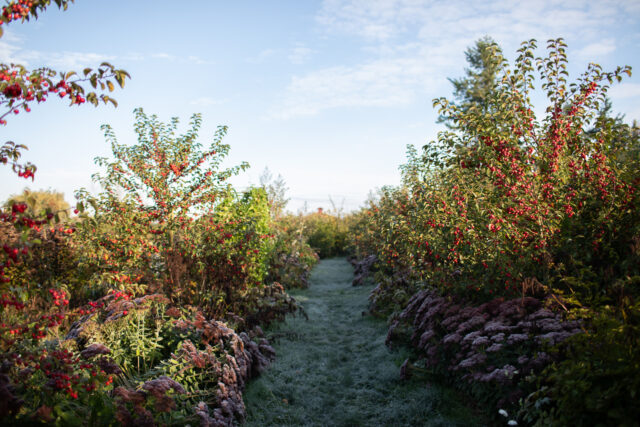 As summer fades, their fruit begins to transform, and with fall’s arrival, their foliage becomes a kaleidoscope of colors. In the winter months, their bare skeletons offer a striking beauty and their remaining fruit provides food for wildlife and songbirds during the coldest time of the year.
As summer fades, their fruit begins to transform, and with fall’s arrival, their foliage becomes a kaleidoscope of colors. In the winter months, their bare skeletons offer a striking beauty and their remaining fruit provides food for wildlife and songbirds during the coldest time of the year.
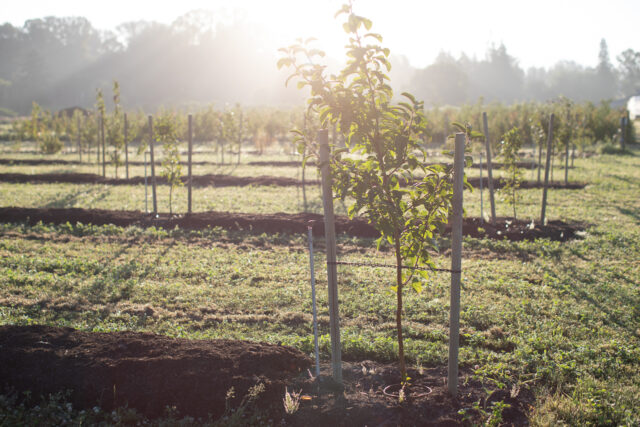 Every season my love for them grows, and I plant as many new varieties as I can possibly find here on the farm. We now have more than 94 cultivars spanning nearly 300 trees! If you’d like the full list of our collection (which also includes sources), scroll to the bottom of this post and enter your email address.
Every season my love for them grows, and I plant as many new varieties as I can possibly find here on the farm. We now have more than 94 cultivars spanning nearly 300 trees! If you’d like the full list of our collection (which also includes sources), scroll to the bottom of this post and enter your email address.
 Most of our trees are still quite young so it’s hard to know which varieties will rise to the top just yet, both ornamentally and for culinary uses like cider, jelly, baking, and fresh eating. But as the trees mature, I’ll be sure to share more about my findings. Below you’ll find a few of my favorites so far.
Most of our trees are still quite young so it’s hard to know which varieties will rise to the top just yet, both ornamentally and for culinary uses like cider, jelly, baking, and fresh eating. But as the trees mature, I’ll be sure to share more about my findings. Below you’ll find a few of my favorites so far.
‘Chestnut’Vigorous trees are healthy, fast growing, and early to flower. They produce small fruit (about the size of a golf ball) and are loved by everyone—especially the kids who visit the farm. Mild and slightly tart, the fruit is excellent fresh and tastes like applesauce. ‘Chestnut’ is one of the first crabapples to ripen.
‘Dolgo’We planted this gem about 15 years ago in our backyard and it continues to impress. The tree has a sprawling habit, with beautiful blush buds and creamy flowers in the spring. The oblong fruit ripens in August and has a wonderful flavor that is great both fresh and cooked.
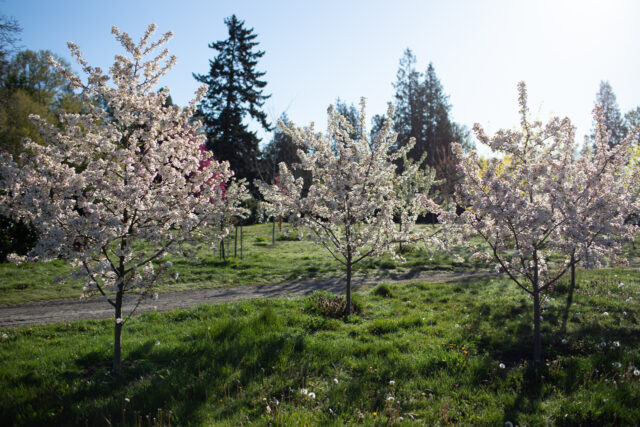 ‘Evereste’ (pictured above) If I could only grow one crabapple, this would be it! The trees are a nice manageable size, topping out at about 12 ft—ideal in a smaller garden. Every April they become a cloud of creamy, double, highly fragrant blooms that persist for weeks. Marble-sized fruit appears in June and begins to color up by July, transforming from green with a blush wash, to orange, and eventually ruby in autumn. I cut fruiting branches all season and tuck them into as many bouquets as I can. The best part is that the tiny apples are firmly attached and don’t fall off when handling. Fruit is very tart and slightly astringent but once fully ripe would be a great addition to sauce or cider.
‘Evereste’ (pictured above) If I could only grow one crabapple, this would be it! The trees are a nice manageable size, topping out at about 12 ft—ideal in a smaller garden. Every April they become a cloud of creamy, double, highly fragrant blooms that persist for weeks. Marble-sized fruit appears in June and begins to color up by July, transforming from green with a blush wash, to orange, and eventually ruby in autumn. I cut fruiting branches all season and tuck them into as many bouquets as I can. The best part is that the tiny apples are firmly attached and don’t fall off when handling. Fruit is very tart and slightly astringent but once fully ripe would be a great addition to sauce or cider.
‘Golden Hornet’I spent years trying to track this tree down and it’s no wonder why it’s such a popular variety in England. The trees are healthy and vigorous, and fruit at a very young age. The marble-sized apples are a glowing yellow and ripen very early in the season. So far I’ve only tasted them past their prime, when the flesh is mushy, but I’m guessing that if caught early they could be good for cooking.
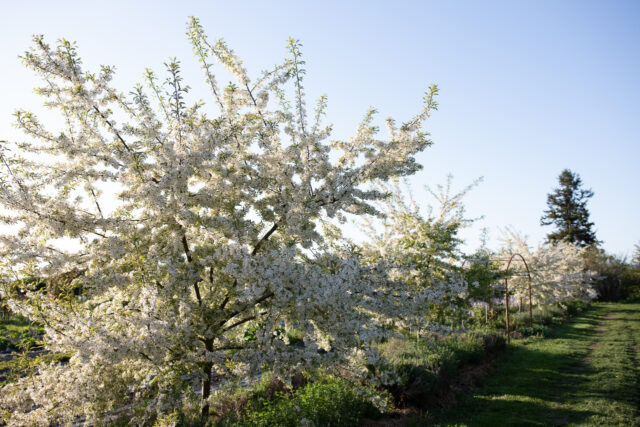 ‘Golden Raindrops’ (pictured above) One of the most beautiful crabapples we grow, this vigorous, healthy tree gets quite large and puts on an amazing show each spring. Branches are long and slender and grow horizontally, giving trees a very rounded shape. The last to flower, thousands of creamy star-shaped blooms burst into a fragrant cloud which the bees go absolutely mad for. You can literally hear the trees buzzing from across the garden. Their leaves are maple-shaped and turn bright gold in the autumn right before dropping to reveal the tiny yellow bead-sized fruit decorating each branch. They aren’t really edible (too small and sour) but the wildlife just love them, especially songbirds.
‘Golden Raindrops’ (pictured above) One of the most beautiful crabapples we grow, this vigorous, healthy tree gets quite large and puts on an amazing show each spring. Branches are long and slender and grow horizontally, giving trees a very rounded shape. The last to flower, thousands of creamy star-shaped blooms burst into a fragrant cloud which the bees go absolutely mad for. You can literally hear the trees buzzing from across the garden. Their leaves are maple-shaped and turn bright gold in the autumn right before dropping to reveal the tiny yellow bead-sized fruit decorating each branch. They aren’t really edible (too small and sour) but the wildlife just love them, especially songbirds.
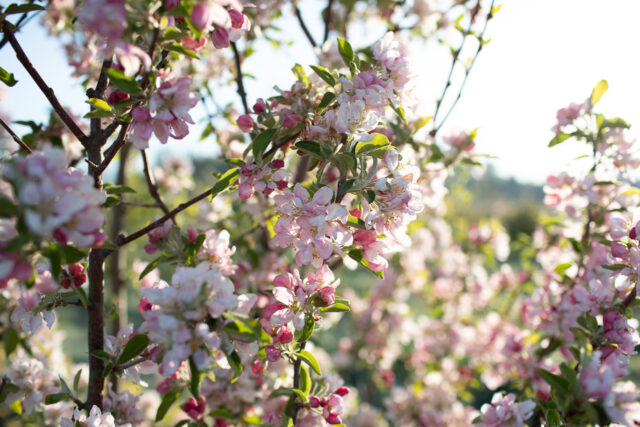 ‘Puget Spice’ (pictured above) This variety was bred right here in Washington at Washington State University and scores extremely high on disease resistance. The compact trees have a very conical, upright growth habit making them a great choice as a street tree or where space is limited. It’s one of the latest to flower for us and is covered in beautiful soft pink blossoms that have a light scent. The fruit is a bit larger than a cherry and has a zingy, tart flavor that would be great in cider or jelly. We eat them fresh but prefer them cooked.
‘Puget Spice’ (pictured above) This variety was bred right here in Washington at Washington State University and scores extremely high on disease resistance. The compact trees have a very conical, upright growth habit making them a great choice as a street tree or where space is limited. It’s one of the latest to flower for us and is covered in beautiful soft pink blossoms that have a light scent. The fruit is a bit larger than a cherry and has a zingy, tart flavor that would be great in cider or jelly. We eat them fresh but prefer them cooked.
‘Sargent’One of the prettiest varieties that flowers each spring, these compact, well-behaved trees would be the perfect addition to a small yard. One of my favorites for cutting, the long slender branches are covered in tiny peachy-blush buds that open to miniature creamy blooms. Bees love it too! The cranberry-red fruit is small, ripens very early, and while not good for eating, the wildlife love it.
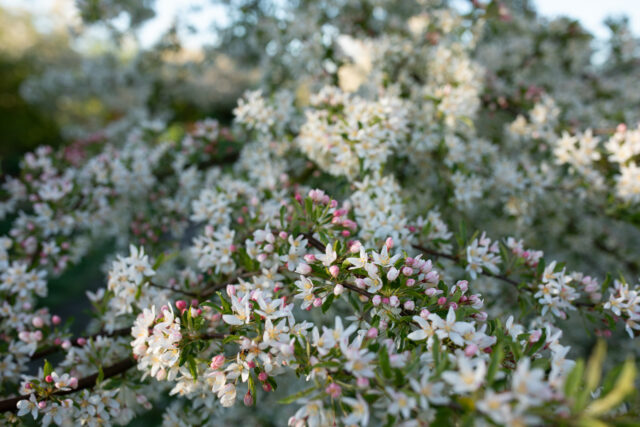 On our crabapple list, you’ll find a handful of very special Sweetmeat Crab™ varieties bred by Albert Etter at the turn of the century. These varieties are a class of small dessert/cider apples and are said to have “intense, robust flavor in a small package.”
On our crabapple list, you’ll find a handful of very special Sweetmeat Crab™ varieties bred by Albert Etter at the turn of the century. These varieties are a class of small dessert/cider apples and are said to have “intense, robust flavor in a small package.”
When Albert died in 1950, his experimental apple orchard fell into decay and neglect until Ram and Marissa Fishman (owners of Greenmantle Nursery) went on a mission to save his trees and decades’ worth of breeding work. They offered Etter’s treasured trees, both his named and trial varieties, in their catalog for many years. Sadly, Ram passed away a few years ago and these trees were nearly lost again. Thankfully, Trees of Antiquity has added them to their offering to ensure they will survive for generations to come.
While I haven’t yet tasted these delightful varieties, I’ve spent almost a decade reading stories about them and patiently waiting for trees to become available. We now have 50 of Etter’s varieties (including both the Sweetmeat™ and red-fleshed Rosetta™ hybrids) in our very own orchard and I’ll share more about them once they set fruit.
Greenmantle Nursery has some wonderful posts on their website about Albert Etter that would make wonderful winter reading. If you read the series about Albert and his trees, you won’t be able to resist adding one of his varieties to your garden!
If you’d like to add crabapples to your garden or farm, here are some of our favorite sources for trees. Late fall to early winter are the best times to pre-order since you’ll find the largest selection. Bare root trees are shipped in early spring, sometime between March and May, depending on your location. Be sure to check with local nurseries too since many carry bare root fruit trees in the winter and they are much more affordable than potted trees.
Crabapple trees are a popular ornamental tree grown for their attractive flowers foliage and fruit. But do all crabapple trees actually produce fruit? The short answer is no, not all crabapple varieties produce fruit. However, most crabapples do bear fruit at maturity. Let’s take a closer look at crabapple fruit production.
What is a Crabapple Tree?
Crabapple trees belong to the genus Malus and are closely related to domestic apple trees. There are over 800 cultivars of crabapple trees available. Crabapples are generally defined as apple trees that produce fruit 2 inches or less in diameter. They are prized for their ornamental qualities, including:
- Profuse and showy spring blossoms in white, pink, and red hues
- Diverse leaf shapes and colors, from purple to variegated
- Attractive form, often weeping, columnar, or rounded shape
- Brightly colored persistent fruits that adorn the tree in fall and winter
In addition to aesthetic appeal some crabapple fruits are edible and can be used to make jellies sauces, and preserves. Birds also relish the fruits.
Do All Crabapples Produce Fruit?
The majority of crabapple trees do bear fruit, but there are some exceptions. Here are the key facts
- Most crabapples produce fruit: Around 75-80% of crabapple cultivars will produce fruit once mature. Fruit usually develops 2-3 years after planting.
- Some varieties are sterile: Approximately 20-25% of crabapples are sterile and do not bear fruit. These are grown strictly for ornamental qualities.
- Fruit production varies: Some crabapples produce heavy fruit crops annually, while others bear lighter or intermittent crops. Crop size depends on cultivar, climate, and growing conditions.
- Not all fruits are edible: Many crabapples produce edible fruits, but some bear bitter, astringent fruits that are only good for ornamental use.
Fruiting Crabapple Trees
The majority of crabapple trees sold produce edible or ornamental fruits. Fruit color varies widely – red, orange, yellow, and purple hues are common. Some popular fruiting varieties include:
- ‘Adams’: A heavy cropping crabapple with bright red fruits perfect for jelly.
- ‘Adirondack’: Large crimson-red fruits persist into winter, also excellent for preserves.
- ‘Centurion’: A rounded tree loaded with yellow-red fruits ideal for wildlife.
- ‘Indian Summer’: Abundant deep red fruits attract birds in droves.
Fruiting crabapples provide multi-season interest with spring blossoms, summer fruits, and persistent winter fruits. The fruits also supply food for birds and other wildlife in your garden.
Non-Fruiting Crabapple Trees
Some crabapple trees are sterile by nature and do not produce any fruits. These are grown strictly for their flowers and foliage. Some popular non-fruiting varieties include:
- ‘Aphrodite’: A slender vase-shaped form prized for pink blossoms and wine-red leaves.
- ‘Prairifire’: Vibrant reddish-purple foliage sets off the rose-pink blooms.
- ‘Spring Snow’: Profuse, fragrant white blossoms grace this strongly weeping crabapple.
Non-fruiting crabapples are mess-free choices ideal for patios, walkways, and other high-traffic areas. They offer multi-season beauty without unwanted fallen fruits.
Factors Affecting Fruit Production
Several factors influence the size of the crabapple fruit crop each year:
- Cultivar: Some crabapples are naturally light fruiters, while others produce heavy crops. Check cultivar descriptions for details on fruiting habit.
- Climate: Crabapples produce the best fruit crops in areas with cool winters and moderate summer temperatures. Extreme summer heat can inhibit fruit set.
- Pollination: Crabapples are self-fertile but fruit production improves with cross-pollination between varieties. Plant more than one kind for better fruit set.
- Age: Young crabapple trees may take 2-3 years after planting to begin fruiting. Fruit load increases as trees mature.
- Pruning and care: Proper pruning, watering, and fertilization encourage prolific fruiting. Neglect can reduce crop load.
Even light fruiting crabapples usually produce at least a small crop of fruits each year. But for the heaviest fruit production, choose heavy fruiting cultivars suited to your climate. Proper planting and care will also maximize fruit crops.
Enjoying Crabapple Fruit
The bright fruits of crabapple trees provide long-lasting color in the garden from midsummer into winter. While the fruits look pretty, most people want to know – can you eat crabapples?
- Edible fruits: Many crabapples bear fruits perfect for cooking and preserving. Choose named cultivars described as having edible or culinary fruits.
- Ornamental fruits: Some crabapples have bitter, tannic fruits best left for the birds. Check fruit descriptions before harvesting.
- Preparing fruits: Edible crabapples often need sugar and spices to counter their tart flavor. They make tasty jellies, juices, pies, and preserves.
- Raw fruits: Most crabapples are too tart for eating raw. But a few sweeter varieties can be enjoyed straight off the tree.
Before ingesting any crabapple fruits, be sure to identify the cultivar and confirm edibility. Unripe and ornamental fruits may cause stomach upset if eaten.
Crabapple Fruit Recap

Mail-Order Nurseries
Blue Hill Wildlife Nursery During my hunt for new crabapples, I stumbled onto this unique mail-order nursery located in Pennsylvania that specializes in varieties of fruit that attract whitetail deer for hunters. I’d never heard of anyone wanting to attract deer to their property! Owner Ryan Haines has been working on a collection of fruit varieties for more than 20 years that produce abundantly from a young age, are disease resistant, cold tolerant, flavorful, and very easy to grow. While he offers many different types of standard-size fruit and nut trees, his crabapples and applecrabs (large-fruited crabs) look amazing. If you aren’t easily offended and want a good chuckle, the names of some of the trees are pretty funny, including ‘Deer Candy’, ‘Road Kill’, and ‘Lockdown’. One thing to note is that trees only go on sale once per year in the fall, so be sure to use the “get alert feature” and put the sale date on your calendar because he sells out very fast.
Burnt Ridge Nursery & Orchards This long-standing, family-owned farm located in Onalaska, Washington specializes in northwest-native plants, fruit and nut trees, and a wide selection of ornamental trees and shrubs that are both fruiting and flowering. I’ve been ordering from this wonderful company for two decades now and I’m always thrilled with my order.
Cummins Nursery This small, New York-based nursery grows and ships thousands of fruit trees from their farm each year. They have a great selection, including lots of stone fruit, cherries, pears, and many types of apples—from red flesh to heirlooms to cider—and a good dozen crabapple varieties, too. I’ve always been really happy with everything I’ve ordered from them and love their tagline: “fruit trees for everyone.”
Fedco SeedsThis long-standing, Maine-based nursery specializes in varieties that perform well in cold climates. In addition to offering seeds, potatoes, onions, bulbs, and growing supplies, they also have a great selection of fruiting plants and trees. I’ve gotten a number of really special heritage varieties from them, including almost a dozen different crabapples. Their bare root trees are tiny when they arrive but will take off quickly once in the ground.
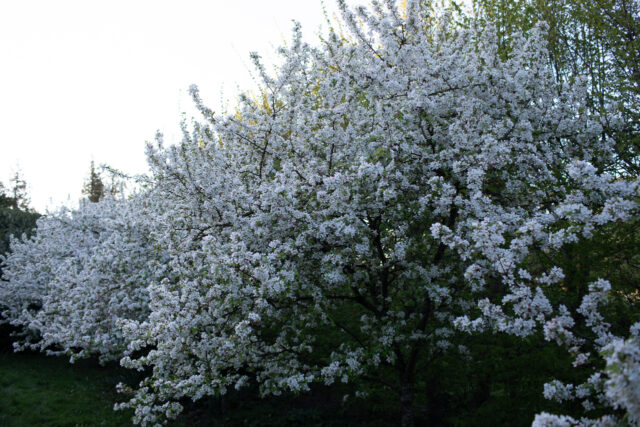 Orange Pippin Fruit TreesOrange Pippin offers more than a dozen great crabapple cultivars including the rare (here in the States) ‘Golden Hornet’ variety. I’ve been very pleased with the quality of their trees.
Orange Pippin Fruit TreesOrange Pippin offers more than a dozen great crabapple cultivars including the rare (here in the States) ‘Golden Hornet’ variety. I’ve been very pleased with the quality of their trees.
Raintree Nursery This specialty nursery located in Morton, Washington has an incredible selection of fruit trees, nut trees, unusual edibles, and berries, all of which have been carefully selected to thrive in the Pacific Northwest. They also offer native plants, ornamental trees, shrubs, and vines.
St. Lawrence Nurseries This nursery is one of my very favorites and has an amazing selection of fruit trees and fruiting plants. Located in Potsdam, New York, St. Lawrence is one of the only nurseries growing their stock in an extreme climate (zone 3), so anything you get from them will survive even the toughest growing conditions. I love that their tagline is “cold hardy plants for cold hardy people.” Owners Connor and Allyssa use organic, regenerative growing methods and all of their trees are planted, tended, and dug by hand to ensure the highest quality. Be sure to sign up for their mailing list (email [email protected] with your address) in order to get their wonderful printed catalog. It’s filled with stories, art, and colorful descriptions and is worth hanging onto because someday it’s sure to be a collector’s item.
Trees of AntiquityThis treasured mail-order nursery has been growing and shipping heirloom fruit trees around the country for more than 40 years. Their collection is unmatched, with 200 different historical apples available this season alone, including many of the Sweetmeat™ and Rosetta™ varieties bred by Albert Etter. If you search “Etter” on their site, all of these special varieties will come up. In addition to their incredible preservation efforts, Trees of Antiquity is also certified organic. I’ve been very impressed with their quality and selection and am excited to continue adding more of their varieties to our farm in the future.
Everything You Need To Know About Crab Apples!
FAQ
What crabapple trees don’t produce fruit?
Spring Snow Crabapple tree is the only fruitless crabapple, making it a dream come true for those tired of dealing with fallen fruit. This variety’s dwarf size is perfect for smaller spaces, ensuring you get all the beauty of a crabapple without overwhelming your garden.
How long does it take for a crabapple tree to bear fruit?
Although it may take 3-5 years for your crabapple tree to mature, you should know that they produce a very large crop every year. Interestingly, you may see these fruits hanging on the tree’s branches in clusters; in fact, the tree more closely resembles a berry tree than a traditional apple tree.
What are the disadvantages of a crabapple tree?
Drawbacks to crabapples include root suckering and messy fruit in the early spring. There are many factors to consider when selecting a crabapple for your garden, including bloom color, fall foliage color, fruit size, tree size, and disease resistance.
Why is my crabapple tree not producing?
There are a few reasons your crabapple might not be blooming right now. This sounds like a small, young tree, so you probably haven’t been doing much pruning, but overly aggressive pruning can sometimes stimulate the tree to flush out vegetative growth rather than flowering.
